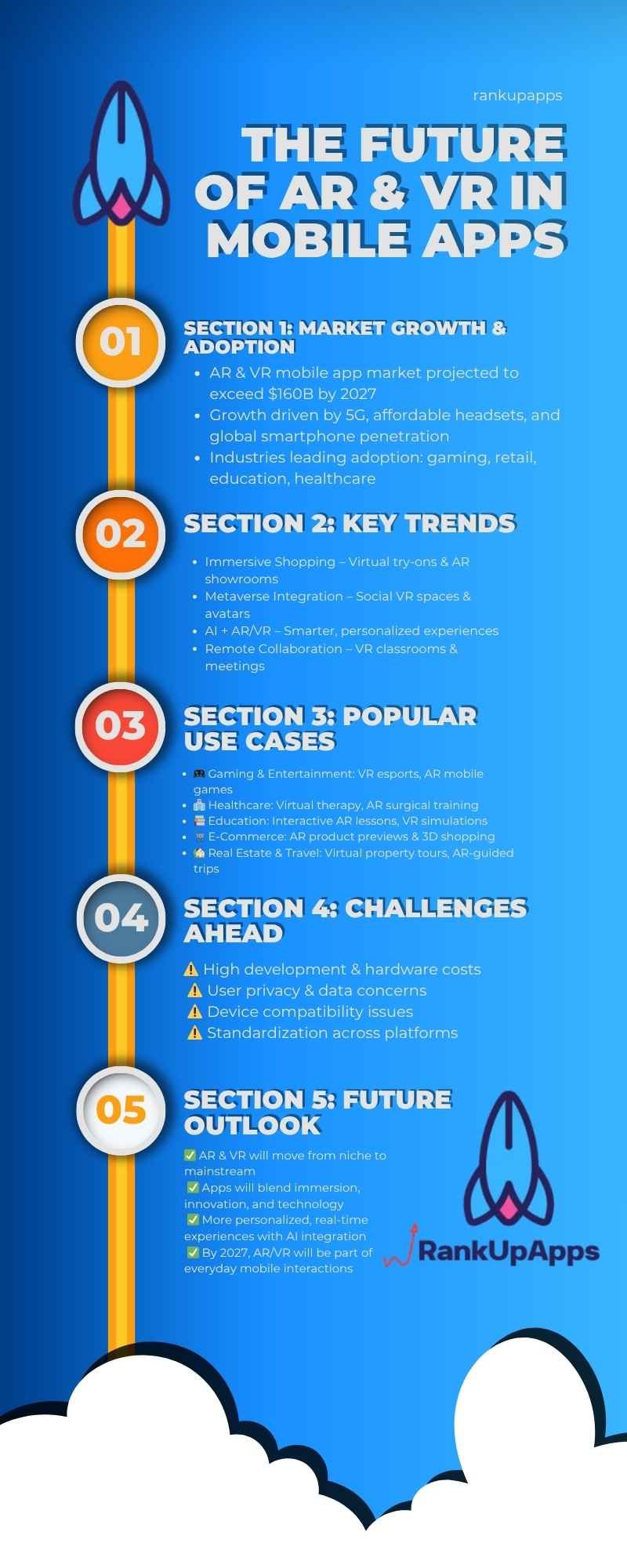The mobile application market is entering its most disruptive phase, driven by the shift to spatial computing. Augmented Reality (AR) and Virtual Reality (VR) are now mainstream in apps, thanks to powerful smartphone hardware and developer frameworks like ARKit. This market, poised for explosive growth, signifies mass adoption across everyday user experiences. The future is clearly mobile, transforming passive consumption into active, immersive engagement. Businesses must fundamentally rethink their AR in mobile apps strategies to interact with the user’s physical world.
Understanding AR & VR in Mobile Applications
The terms AR and VR are often used interchangeably. However, they actually represent two fundamentally different approaches to immersive technology. Crucially, each approach has unique capabilities in mobile applications.
What Is Augmented Reality (AR) in Apps?
Augmented Reality (AR) works by overlaying digital information such as 3D models, graphics, or data onto the user’s real-world environment. In essence, it acts as an enhancement. It utilizes the smartphone’s camera to process the environment and place virtual elements within it. Common examples include interactive social media filters, which map digital masks onto faces. Similarly, immersive shopping experiences allow users to preview furniture in their living room before purchasing. AR is characterized by its reliance on the existing physical environment. Therefore, it is highly accessible through standard smartphones.
What Is Virtual Reality (VR) in Apps?
Virtual Reality (VR), conversely, creates a completely fabricated, three-dimensional environment. This environment fully immerses the user, cutting off their view of the real world. In the context of VR mobile applications, this is usually achieved via smartphone-powered headsets (like Google Cardboard). Nevertheless, dedicated standalone headsets are quickly becoming the norm. Use cases revolve around total immersion, including gaming, high-fidelity corporate training simulations, or fully rendered virtual property tours. VR’s primary goal is to create a powerful sense of ‘presence’ within a new digital world.
AR vs VR – Key Differences & Use Cases
While both fall under the umbrella of extended reality (XR), their application differs significantly. AR focuses on practical, real-world enhancement. In contrast, VR delivers entirely new, immersive worlds. The choice between AR mobile apps and VR mobile applications depends entirely on the required level of immersion. Furthermore, it hinges on whether interaction with the physical environment is necessary.
| Aspect | AR (Augmented Reality) | VR (Virtual Reality) |
| Experience | Enhances real world | Creates new world |
| Devices | Smartphones, AR glasses | VR headsets |
| Best For | Retail, navigation, education | Gaming, training, real estate |
| Example | IKEA Place app (furniture preview) | Meta Quest 3 gaming / Surgery simulators |
The Current Role of AR & VR in Mobile App Development
Market Growth and Trends in AR/VR
The AR VR app trends show a clear trajectory toward market dominance. The global XR market is projected to reach well over a billion by 2025. Significantly, mobile AR is driving the largest portion of consumer revenue. Indeed, this growth is fueled by improved spatial tracking, cloud rendering capabilities, and increasing device accessibility. Developers are shifting from building novelty experiences. Instead, they are creating persistent, location-based AR content. It means the virtual elements stay anchored in the real world for all users. Ultimately, this persistence is key to scaling usage.
Key Sectors Driving Adoption
Adoption is strongest in several crucial sectors:
- Gaming: Continues to be a primary driver, with AR VR market growth fueled by titles that blend the real and digital worlds (e.g., Pokémon GO).
- Retail: AR try-ons have become standard, reducing return rates and increasing consumer confidence.
- Healthcare: VR is used extensively for pain management and cognitive therapy, while AR aids in diagnostics and training.
- Education: AR apps allow students to dissect virtual models or visualize complex data in 3D, moving beyond traditional textbooks.
- Real Estate: VR offers cost-effective, global property viewings.
AR & VR in Everyday Mobile Use
The penetration of AR and VR into daily life is evident. For example, AR mobile apps like Instagram and TikTok utilize sophisticated face-mapping technology for their filters. It makes AR a universally accepted form of communication. E-commerce platforms integrate AR shopping try-ons for everything from eyeglasses to clothing. In addition, basic VR property tours are becoming standard for potential buyers. Specialized mobile training modules also use immersive technology to onboard new employees. Clearly, AR and VR are no longer just future concepts, but essential features of modern mobile applications.
Benefits of AR & VR in Mobile Apps
Integrating immersive technologies offers profound competitive advantages across various industries, dramatically improving customer experience and operational efficiency.
- Enhanced User Engagement – immersive experiences.
- Benefit: AR and VR convert passive screen time into interactive, three-dimensional experiences. Consequently, this level of interaction drives longer session times, higher stickiness, and a stronger emotional connection to the brand or service. For instance, an AR tourism app allows users to see historical sites rebuilt in their current location. It offers engagement far surpassing simple text and images.
- Boost in E-Commerce Sales – virtual try-ons.
- Benefit: The ability to visualize products accurately within a personal context significantly reduces the uncertainty of online shopping. Specifically, users can place a new sofa in their living room via an AR app. This tangible preview drives substantial increases in confidence. Therefore, it leads to fewer returns and measurable growth in e-commerce sales, highlighting the direct benefits of AR in apps.
- Improved Education & Training – VR classrooms, AR simulations.
- Benefit: VR provides high-risk training simulations in a safe, controlled environment (e.g., machinery repair). Furthermore, VR advantages mobile apps by allowing students to learn kinesthetically. AR apps, for example, those that superimpose diagnostic information onto patient scans in healthcare, accelerate learning. They also improve retention rates by providing context-aware information.
- Healthcare Innovation – remote surgeries, AR diagnostics.
- Benefit: AR provides surgical teams with real-time patient data overlaid onto the operating field. Consequently, this enhances surgical precision. Mobile VR therapy apps offer guided meditation and exposure therapy for phobias. Specifically, they utilize the immersive environment to deliver powerful, personalized mental health treatments.
- Tourism & Real Estate – virtual property and travel previews.
- Benefit: High-quality VR property and travel previews circumvent the cost and time required for physical travel. Users can walk through hotel rooms, museums, or overseas properties from their mobile device. Therefore, this makes the planning and purchasing decision process far more efficient. It also reduces friction for transactions. The high degree of visual fidelity provided by AR VR user engagement makes these virtual tours highly persuasive.
Industries Leading the Future of AR & VR Mobile Apps
The adoption curve of AR and VR is distinct across sectors, with a few key industries paving the way for mass consumer adoption.
1. Gaming & Entertainment
Gaming remains the primary engine driving consumer adoption. AR VR in gaming has successfully evolved from niche demos to highly polished, scalable experiences.
- Mass Appeal: Mobile AR games, famously demonstrated by Pokémon GO, proved the viability and mass appeal of location-based AR.
- Mobile-First Immersion: VR entertainment is increasingly mobile-first, utilizing standalone headsets powered by mobile-grade chips to deliver highly polished, room-scale gaming without requiring expensive PCs.
- Blended Play: The key future trend is the merging of these environments, allowing players to move seamlessly between physical play spaces and rich digital overlays.
2. Retail & E-Commerce
Retail is capitalizing on AR’s practical utility to solve the biggest hurdle in online shopping: the inability to interact physically with a product.
- Conversion and Confidence: AR in retail apps has shifted consumer behavior by introducing virtual furniture previews (IKEA) or AR fitting rooms for clothing. These features address customer uncertainty directly.
- Logistical Savings: This capability translates directly into higher conversion rates and significantly reduced logistical costs associated with product returns, proving AR’s immediate ROI.
3. Healthcare & Training
In these sectors, AR and VR are not just enhancements—they are mission-critical tools that improve outcomes and lower risk.
- Procedural Accuracy: VR in healthcare provides safe, repeatable environments for precise surgical training and controlled exposure therapy for mental health disorders.
- Patient Education: AR is used for patient education, allowing doctors to use tablets or phones to display 3D anatomical overlays onto the patient’s body. It drastically enhances patient understanding and compliance with treatment plans.
4. Real Estate & Travel
Both industries rely heavily on the power of visualization to convert leads, making them ideal candidates for immersive technology.
- Visualizing the Future: AR in real estate allows potential buyers to visualize properties that are still under construction or see renovation options overlaid onto existing empty rooms.
- Immersive Previews: Travel apps use VR to offer deep, immersive destination previews, helping travelers select locations with a level of detail and confidence that static photos or videos cannot match. It reduces the purchase risk and enhances the overall customer journey.
Technologies Powering the Future of AR & VR Apps
The next generation of mobile AR and VR applications will be defined not just by hardware, but by network and computing advancements.
1. 5G & Edge Computing: Reducing Latency
High-fidelity AR and VR demand immense data throughput and near-zero Latency, which traditional networks cannot provide.
- 5G AR VR Apps: These leverage the sheer speed of 5G networks to stream complex virtual environments and rich digital assets instantly. It is essential for detailed, dynamic visuals.
- Edge Computing: This critical advancement moves intense rendering and processing power closer to the user, the “network edge.” By offloading complex tasks from the local device to the edge, it drastically reduces lag and enables highly realistic, graphics-intensive experiences on standard mobile hardware.
2. AI & Machine Learning: Intelligence and Personalization
Artificial Intelligence is fundamental to transforming immersive environments from static views into intelligent, responsive experiences.
- Real-World Understanding: Machine Learning (ML) powers sophisticated object recognition, allowing AR apps to instantly identify and understand real-world surfaces, rooms, and physical objects for precise and accurate overlay placement.
- Dynamic Personalization: AI in AR VR enables real-time adaptation. It can adjust virtual environments or modify AR content based on user behavior, emotional state, or real-time context, making every interaction highly relevant and unique.
3. AR Cloud & Persistent AR: A Shared Digital World
The AR Cloud is a foundational technology creating a shared, persistent digital twin of the physical world.
- Shared Reality: It acts as a digital copy of the planet, allowing AR content to remain anchored in a specific real-world location for everyone to see. It is the key to multi-user experiences.
- Next-Gen Apps: This persistence is critical for location-based games, shared virtual collaboration spaces, and long-term digital signage that defines the next evolution of AR Cloud apps.
4. IoT & Wearables Integration: Contextual Awareness
The blending of physical data with virtual interfaces enhances immersion and utility.
- Environmental Context: Integration with the Internet of Things (IoT) and smart wearables allows AR/VR apps to gather real-time environmental data (like temperature or lighting) and personal biometric data (like heart rate).
- Enhanced Experiences: This contextual awareness is used to create highly adaptive, personalized immersive experiences, such as stress-reducing VR environments that respond directly to a user’s heart rate.
Challenges in AR & VR Mobile App Development
Despite the clear benefits and momentum, the path to mass AR/VR adoption is currently constrained by several key obstacles that developers must address.
- High development costs and complexity: Creating high-fidelity 3D assets and implementing complex spatial tracking algorithms require specialized skills. In addition, optimizing performance across diverse hardware platforms adds complexity. Consequently, this leads to significantly higher development costs compared to traditional 2D mobile apps.
- Smartphone hardware limitations and fragmentation: While modern phones are powerful, sustained high-quality AR/VR experiences quickly drain battery life. Moreover, they generate excessive heat. Furthermore, the wide range of Android device capabilities creates fragmentation issues. Therefore, making consistent performance delivery is challenging.
- UX design and motion sickness issues: VR, in particular, must overcome user experience hurdles like motion sickness. It often results from Latency or misalignment between the user’s physical movement and the visual feedback. Consequently, designing intuitive, standardized navigation within a 3D space is a complex and evolving field.
- Data security & privacy concerns over spatial data: AR apps collect massive amounts of data about the user’s physical environment (room layouts, objects, even biometric data). Protecting this sensitive spatial data is crucial. Furthermore, ensuring user consent for its collection and use poses a significant security and regulatory challenge for future AR VR app development issues.
- Lack of standardized input methods: Unlike a 2D screen with taps and swipes, AR/VR still lacks a universally accepted input mechanism (gestures, voice, controllers). As a result, this complicates intuitive design and increases the learning curve for new users.
The Future Outlook of AR & VR in Mobile Apps
The trajectory of the future of AR apps and the future of VR apps is moving toward convergence and ubiquity, largely driven by increasingly capable mobile devices.
Predictions for 2025 and Beyond
By 2025, it is predicted that nearly 80% of all new flagship mobile devices will be AR-enabled. Thus, the technology will become a standard feature, not a differentiator. The focus will shift from gaming to widespread adoption in specialized verticals. For instance, every major retailer will have an AR try-on feature; healthcare will integrate AR for remote diagnostics; and education will utilize VR platforms for remote, interactive schooling. The major prediction, however, is the rise of the lightweight AR glasses. These devices will replace the phone as the primary interface and make AR constantly available.
How Businesses Can Prepare
Businesses must stop viewing AR/VR as a marketing gimmick. Instead, they should start seeing it as a core technology layer. Preparation involves investing in developer talent skilled in spatial computing and 3D design. It also requires transitioning existing data and product libraries into 3D assets. Furthermore, businesses need to establish a roadmap for integrating immersive features directly into their primary consumer application. Early adopters, consequently, will gain valuable market share and expertise in the nuanced area of spatial UI/UX.
The Role of Developers & Startups
Developers and startups are the engine of this transformation. They are tasked with refining the user experience, eliminating motion sickness, and innovating solutions that leverage 5G and AI. The AR VR app development future belongs to those who can master cross-platform deployment. Specifically, they must create persistent digital content. Moreover, they must build applications that intuitively blend the user’s real and virtual lives seamlessly.
Case Study / Table Section – AR vs VR in Mobile Apps
This table summarizes the core differences and primary applications that define the current immersive mobile landscape.
| Aspect | AR (Augmented Reality) | VR (Virtual Reality) |
| Experience | Enhances real world | Creates new world |
| Devices | Smartphones, AR glasses | VR headsets |
| Best For | Retail, navigation, education | Gaming, training, real estate |
| Example | IKEA AR app (furniture preview) | Oculus VR gaming / Surgery simulators |
Key Takeaways – Why AR & VR Will Dominate Mobile Apps
The convergence of 5G, edge computing, and AI has created a perfect storm for immersive technologies. Therefore, they are poised to dominate the mobile landscape. The AR VR mobile apps future is not about replacing mobile devices. Rather, it is about transforming them into highly intelligent windows onto a blended reality. AR, for example, offers practical, contextual applications—like helping you choose a sofa or navigate a city. This makes the world around you smarter. Conversely, VR provides deeply engaging, safe, and cost-effective immersive experiences for training and entertainment. Together, they define the future of digital engagement, shifting the mobile experience from content consumption to environmental interaction. Developers who recognize the screen as simply the boundary of a larger, spatial interface are already leading the charge in immersive mobile app development.
Conclusion – The Future of Mobile Apps Is Immersive With AR & VR
The era of the 2D mobile app is drawing to a close. As 3D models and cloud-rendered complexity become standard, AR and VR will soon be the default methods for mobile interaction. In short, this shift is the most significant platform change since the smartphone’s launch. For businesses, adopting these AR VR technology apps is no longer optional; it is, in fact, a necessity for survival. Those that invest early in spatial computing expertise and robust immersive experiences will capture customer attention and drive engagement. Ultimately, they will win the next generation of digital commerce and communication. The future of mobile is immersive, collaborative, and entirely spatial.




